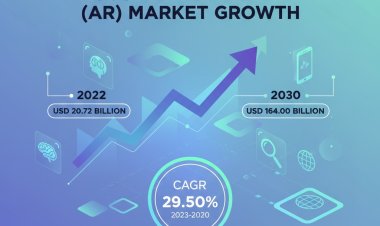Global 3D Printing Market Size to Reach $48.67 Billion at a CAGR of 18.4% by 2030
Vantage Market Research expects the 3D Printing Market to reach USD 48.67 Billion by 2030, exhibiting a growth rate (CAGR) of 18.4% during 2024-2030.

The Global 3D Printing Market size reached USD 12.6 Billion in 2022. Vantage Market Research expects the market to reach USD 48.67 Billion by 2030, exhibiting a growth rate (CAGR) of 18.4% during 2024-2030.
Table of Contents
|
Introduction: |
|
|
Regional Dynamics Shaping the 3D Printing Landscape: |
|
|
|
|
|
Overcoming Hurdles and Embracing Change: |
|
|
|
Market Trends and the Evolving Landscape: |
|
|
|
|
Connecting the Digital Thread: Redefining the Supply Chain: |
|
|
|
The Future of 3D Printing: Trends and Expectations: |
|
|
|
|
India's Rise and Global Innovation Insights: |
|
|
|
Conclusion: |
|
The Age of On-Demand Manufacturing: How 3D Printing is Changing Everything
In recent years, the manufacturing industry has experienced a transformation with the advent of 3D Printing technology, causing a major stir worldwide. This transformation is fueled by digital advancements that are reshaping traditional manufacturing methods. In this blog, we'll explore the regional influences and industry players driving the age of on-demand manufacturing.
Request Sample Report of 3d Printing Market @ https://www.vantagemarketresearch.com/3d-printing-market-2375/request-sample
Top Companies in Global 3D Printing Market
- Stratasys Ltd. (Israel)
- 3D Systems (U.S.)
- EOS GmbH (Germany)
- SLM Solutions (Germany)
- CleanGreen3D Limited (Ireland)
- Protolabs (U.S.)
- Materialise NV (Belgium)
- GE (U.S.)
- Voxeljet (Germany)
- HP (Spain)
- Optomec (U.S.)
- Groupe Gorgé (France)
- Ultimaker (Netherlands)
Regional Dynamics in the 3D Printing Revolution
United States: A Hub of Innovation
The United States is at the forefront of embracing 3D Printing technology, with a growing demand for application. The country has become a promising customer for 3D technology, with a significant focus on research and development. The 3D Printing revolution has gained traction in the United States in sectors such as healthcare and aerospace. This widespread acceptance of manufacturing has cemented the country’s position as a player in this innovative technology.
China's Ambitious Strive
China, a manufacturing powerhouse, perceives 3D Printing as a threat and an opportunity for industrialization. Chinese companies are making investments in the field of printing technology to uphold their position as global leaders in manufacturing. The competition is fierce, as China views this technology as a way to stay ahead in the global industrial sector.
U.K.'s Policy Amidst Uncertainty
While the United Kingdom government has developed a 3D Printing innovation policy, concerns about Brexit uncertainty linger within the industrial sector. The future of 3D Printing in the United Kingdom is still uncertain despite the policy initiatives. This uncertainty arises as the country grapples with the challenges that come along with its departure from the European Union.
Germany's Firm Industry 4.0 Stance
Germany, known for its robust Industry 4.0 framework, is likely to generate modern innovation strategies in 3D Printing. The country's emphasis on advanced manufacturing technologies positions it as a critical influencer in the evolving landscape of on-demand manufacturing.
Overcoming the Hurdles: Rise of Desktop 3D Printers
The high initial costs are a significant hurdle hindering the widespread adoption of 3D Printing. Investments in technology, materials, software, certification, and employee training contribute to the barrier. However, the development of industrial desktop 3D printers is gradually mitigating this challenge. These printers are both user-friendly and more cost-effective, making 3D Printing accessible to a broader audience.
COVID-19's Impact: A Catalyst for Change
The outbreak of COVID-19 disrupted industries worldwide, significantly impacting the medical sector. The increased demand for personal protective equipment (PPE) and medical supplies exposed vulnerabilities in traditional supply chains. 3D Printing emerged as a solution, allowing manufacturers to rapidly produce essential medical equipment locally, overcoming shortages and supply chain challenges.
North America Dominates a Glimpse at Market Trends
North America, particularly the United States and Canada, dominated the 3D Printing market, generating over 43.50% of total revenues in 2022. The region's widespread use of additive manufacturing and the adoption of 3D Printing in diverse sectors like healthcare and consumer electronics contributed to this dominance.
The Shifting Landscape of Additive Manufacturing
As industries grapple with challenges such as fluctuating fuel costs, geopolitical uncertainties, and ongoing geopolitical conflicts, additive manufacturing (AM) has proven to be a resilient and innovative solution. The AM world is evolving with two distinct groups: advanced users seeking increased reliability and performance and exploratory users looking for guidance in deploying and integrating 3D Printing technologies into their manufacturing processes.
Training and Upskilling: A Core Component of Growth
Training and upskilling are imperative to harness the potential of additive manufacturing fully. The industry is witnessing a surge in online and virtual training and education demand. The shift towards application-driven factory concepts necessitates the optimization of industrial 3D printers, periphery, and post-processing to maximize throughput and minimize costs.
Connecting the Digital Thread: A Decentralized Supply Chain
Additive manufacturing connects the physical supply chain with a digital thread, allowing for more efficient management of products from concept to end-of-life. This decentralization fosters a collaborative, transparent, and efficient supply chain, as demonstrated during the COVID-19 pandemic when 3D Printing was crucial in overcoming supply chain challenges.
Materials Matter: Sustainable Innovations
The additive manufacturing industry is witnessing substantial investments in materials. Hybrid 3D Printing materials, uniquely engineered for specific applications, are emerging to meet the diverse challenges faced by different sectors. Sustainability is a key focus, with efforts to enhance recyclability and biodegradability. Manufacturers like EOS are actively working on making 3D printers and materials more energy-efficient and sustainable, aligning with the principles of the circular economy.
Buy Now Our 3D Printing Industry Report @ https://www.vantagemarketresearch.com/buy-now/3d-printing-market-2375/0
The Future of 3D Printing: Trends and Expectations
Looking ahead to 2023, several trends are expected to shape the 3D Printing landscape:
Industry Standardization: Adopting the 3mf file format for storing comprehensive printing information.
On-Demand Manufacturing: Increased integration with inventory systems for just-in-time manufacturing.
High-Performance Materials: Development of advanced materials like refractory metals, ceramics, and composites.
Sustainability Drive: Continued focus on sustainable 3D Printing materials and processes.
Supply Chain Resilience: 3D Printing's role in building resilient and localized supply chains.
Collaborative Ecosystem: Closer collaborations among service providers, material producers, and print farms.
India's Rise in 3D Printing Innovation
India has seen a surge in the adoption of printing technologies, with both government entities and private companies actively involved in various 3D Printing initiatives. Notable achievements include the Indian Space Research Organization's collaborations with private companies and the Defense Research and Development Organization's certification of key aero engine components produced using 3D Printing.
Global Insights from Patent Data
The international patent landscape provides insights into the global innovation trends in additive manufacturing. The impressive rise of 3D Printing innovation is evident, with over 50,000 international patent families related to AM technologies filed since 2001. The United States and Europe lead the innovation race, contributing to 73% of worldwide AM innovation. Major players, in the industry such as General Electric, Raytheon Technologies and Siemens are spearheading progress, in this field.
Conclusion
In conclusion, the age of on-demand manufacturing powered by 3D Printing is well underway. Despite challenges and uncertainties, the industry is evolving, driven by technological advancements, regional influences, and collaborative efforts.
Read Our Latest Press Release: Atherectomy Devices Market - In-depth Analysis
Contact us
Eric Kunz
6218 Georgia Avenue NW Ste 1 - 564
Washington DC 20011-5125
United States Tel: +1 202 380 9727
Email: [email protected]
Website: Vantage Market Research


















